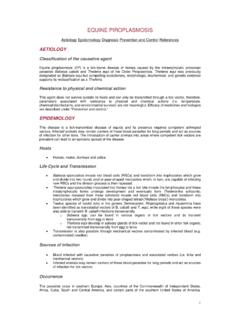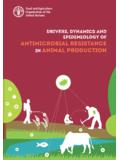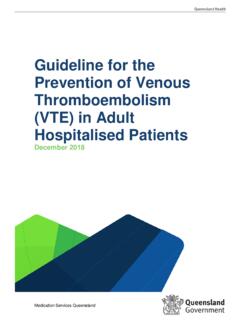Transcription of SEFH2019 Project Category List - sefhouston.org
1 Updated 2018 Project CATEGORIES Animal Sciences Behavioral & Social Sciences Biochemistry & Microbiology Chemistry Computer Sciences Earth & Space Sciences Energy & Transportation Environmental Sciences Engineering: Mathematics Medicine & Health - Aerospace Physics & Astronomy Robotics & Intelligent Machines Plant Sciences - Chemical - Civil - Electrical & Mechanical - Materials & Bioengineering Updated 2018 SCIENCE FAIR Project DEFINITIONS SEFH has aligned majority of its Project categories/definitions with Intel ISEF. Differences in Category title or content on behalf of SEFH are in red text. Category International Science Fair Science and Engineering Fair of Houston Animal Sciences This Category includes all aspects of animals and animal life, animal life cycles, and animal interactions with one another or with their environment.
2 Examples of investigations included in this Category would involve the study of the structure, physiology, development, and classification of animals, animal ecology, animal husbandry, entomology, ichthyology, ornithology, and herpetology, as well as the study of animals at the cellular and molecular level which would include cytology, histology, and cellular physiology. Animal Behavior (BEH): The study of animal activities which includes investigating animal interactions within and between species or an animal s response to environmental factors. Examples are animal communication, learning, and intelligence, rhythmic functions, sensory preferences, pheromones, and environmental effects on behaviors, both naturally and experimentally induced. Cellular Studies (CEL): The study of animal cells involving the use of microscopy to study cell structure and studies investigating activity within cells such as enzyme pathways, cellular biochemistry, and synthesis pathways for DNA, RNA, and protein.
3 Development (DEV): The study of an organism from the time of fertilization through birth or hatching and into later life. This includes cellular and molecular aspects of fertilization, development, regeneration, and environmental effects on development. Ecology (ECO): The study of interactions and behavioral relationships among animals, and animals and plants, with their environment and with one another. Genetics (GEN): The study of species and population genetics at the organismal or cellular level. Nutrition and Growth (NTR): The study of natural, artificial, or maternal nutrients on animal growth, development, and reproduction including the use and effects of biological and chemical control agents to control reproduction Animal Sciences: This Category includes all aspects of animals (mammals, reptiles, birds, insects, etc.)
4 And animal life, development, animal life cycles, and animal behavior with one another and their environment, and including the study at the cellular and molecular level. Updated 2018 Category International Science Fair Science and Engineering Fair of Houston and population numbers. Physiology (PHY): The study of one of the 11 animal systems. This includes structural and functional studies, system mechanics, and the effect of environmental factors or natural variations on the structure or function of a system. Similar studies conducted specifically at the cellular level should select the cellular studies subcategory. Systematics and Evolution (SYS): The study of animal classification and phylogenetic methods including the evolutionary relationships between species and populations. This includes morphological, biochemical, genetic, and modeled systems to describe the relationship of animals to one another.
5 Other (OTH): Studies that cannot be assigned to one of the above subcategories. Behavioral and Social Sciences The science or study of the thought processes and behavior of humans and other animals in their interactions with the environment studied through observational and experimental methods. Clinical and Developmental Psychology (CLN): The study and treatment of emotional or behavioral disorders. Developmental psychology is concerned with the study of progressive behavioral changes in an individual from birth until death. Cognitive Psychology (COG): The study of cognition, the mental processes that underlie behavior, including thinking, deciding, reasoning, and to some extent motivation and emotion. Neuro-psychology studies the relationship between the nervous system, especially the brain, and cerebral or mental functions such as language, memory, and perception.
6 Physiological Psychology (PHY): The study of the biological and physiological basis of behavior. Sociology and Social Psychology (SOC): The study of human social behavior, especially the study of the origins, organization, institutions, and development of human society. Sociology is concerned with all group activities-economic, social, political, and religious. Other (OTH): Studies that cannot be assigned to one of the above subcategories. Behavioral and Social Sciences: This Category includes the study of psychology, sociology, anthropology, archeology, etiology, ethnology, linguistics, animal behavior (learned or instinctive), learning, perception, urban problems, gerontology, reading problems, public opinion surveys, and education testing, etc. Updated 2018 Category International Science Fair Science and Engineering Fair of Houston Biochemistry The study of the chemical basis of processes occurring in living organisms, including the processes by which these substances enter into, or are formed in, the organisms and react with each other and the environment.
7 Analytical Biochemistry (ANB): The study of the separation, identification, and quantification of chemical components relevant to living organisms. General Biochemistry (GNR): The study of chemical processes, including interactions and reactions, relevant to living organisms. Medicinal Biochemistry (MED): The study of biochemical processes within the human body, with special reference to health and disease. Structural Biochemistry (STR): The study of the structure and or function of biological molecules. Other (OTH): Studies that cannot be assigned to one of the above subcategories. Biochemistry/Microbiology: This Category includes molecular biology, molecular genetics, enzymes, photosynthesis, blood chemistry, protein chemistry, food chemistry, hormones, bacteriology, virology, protozoology, fungal and bacterial genetics, yeast, etc.
8 Cellular and Molecular Biology This is an interdisciplinary field that studies the structure, function, intracellular pathways, and formation of cells. Studies involve understanding life and cellular processes specifically at the molecular level. Cell Physiology (PHY): The study of the cell cycle, cell function, and interactions between cells or between cells and their environment. Genetics (GEN): The study of molecular genetics focusing on the structure and function of genes at a molecular level. Immunology (IMM): The study of the structure and function of the immune system at the cellular level. This includes investigations of innate and acquired (adaptive) immunity, the cellular communication pathways involved in immunity, cellular recognition, graft vs host and host vs graft disease, and interactions between antigens and antibodies.
9 Molecular Biology (MOL): The study of biology at the molecular level. Chiefly concerns itself with understanding the interactions between the various systems of a cell, including the interrelationships of DNA, RNA and protein synthesis and learning how these interactions are regulated, such as during transcription and translation, the significance of introns and exons or coding issues. Neurobiology (NEU): The study of the structure and function of the nervous system at the cellular or molecular level. N/A Updated 2018 Category International Science Fair Science and Engineering Fair of Houston OTH Other (OTH): Studies that cannot be assigned to one of the above subcategories Computation Biology and Bioinformatics Studies that primarily focus on the discipline and techniques of computer science and mathematics as they relate to biological systems.
10 This includes the development and application of data-analytical and theoretical methods, mathematical modeling and computational simulation techniques to the study of biological, behavior, and social systems. Biomedical Engineering (BME): The application of engineering principles and design concepts to medicine and biology for healthcare purposes. Computational Biomodeling (MOD): Studies that involve computer simulations of biological systems most commonly with a goal of understanding how cells or organism develop, work collectively and survive. Computational Evolutionary Biology (EVO): A study that applies the discipline and techniques of computer science and mathematics to explore the processes of change in populations of organisms, especially taxonomy, paleontology, ethology, population genetics and ecology. Computational Neuroscience (NEU): A study that applies the discipline and techniques of computer science and mathematics to understand brain function in terms of the information processing properties of the structures that make up the nervous system.








